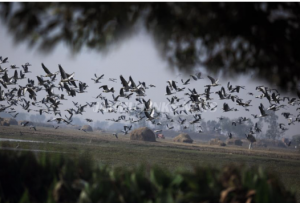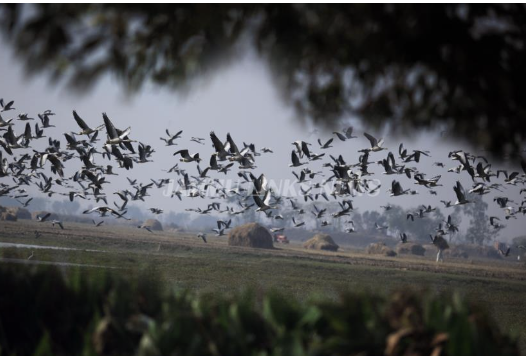JAMMU: Thousands of migratory birds, from egrets to bar-headed geese, descend on the Gharana Wetland Conservation Reserve near the International Border in the outskirts of Jammu city each year in a stunning natural occurrence. About 6,000 bar-headed geese and other species from the northern hemisphere travel to the marsh, which is about 35 km from Jammu, every winter, making it a “haven for bird enthusiasts.” Over 6,000 different kinds of migrating birds, mostly bar-headed geese, make their annual visit to the Gharana Wetland. Over 3,000 to 4,000 of these birds have flown in from the northern hemisphere this year. The Gharana Wetland Conservation Reserve’s (GWCR) in-charge, Simple Singh, stated that more of them are anticipated.According to him, the quantity of migrating birds using this winter habitat rises year. “Everything for guests is being organised here by the department of wildlife. Schools take their kids on field trips to the Gharana’, Singh continued. During the winter months, hundreds of people swarm the marsh, usually photographers and students hoping to catch a sight of the migratory birds. Asvina, an Institute of Music and Fine Arts student, remarked, “It is an ideal place for wildlife photography as you get to shoot over 300 species of migratory birds, particularly Siberian cranes.” “I enjoy taking pictures of outdoors, wildlife, and birds. This place is a bird lover’s dream, therefore I’m thrilled to be here,” Asvina remarked.Sakshi, a student at Jammu University, adds that visiting this place offers the chance to learn about all facets of the natural world, including birds. “There were a lot of people in this area. We’ve been able to photograph in close proximity to nature and get knowledge of several facets of photography,” she remarked. More than 170 people live in the Gharana village of the GWCR, which is surrounded by wetlands in Makwal, Kukdian, Abdullian, and Pargwal. During the winter, migratory bird species like bar-headed geese, gadwalls, common teals, purple swamp hens, Indian moorhens, black-winged stilts, cormorants, egrets, and green shanks flock there, according to officials. Gurdaspur, Punjab’s Rohit Kumar remarked, “I am amazed to see so many different bird species here. We came here to view the migratory birds because my maternal uncle had told me about their flying to Gharana,” he added. Despite measures to safeguard the avian visitors, the wetland on the Indo-Pak border has seen an increase in foot traffic. According to the officials, construction projects like fencing are being carried out in order to safeguard migrating birds and their wintering grounds. “A number of migratory bird species visit this area from overseas, including the Siberian crane. We were delighted to witness a variety of exquisite migratory birds passing through this area. They are ignorant of international boundaries. According to them, this is a world without borders,” Farmers Produce Organisation (FPO) member Sidharth Kumar remarked. Gharana is located on the Central Asian Flyway and was designated as an Important Bird Area (IBA) by the Bombay Natural History Society and BirdLife International (UK). According to the officials, conservation efforts, such as scientific management interventions and a five-year management plan created in association with the World Wide Fund for Nature (WWF), are intended to protect the wetland, encourage ecotourism, and elevate its standing as an important travel destination. They also stated that the administration is dedicated to protecting this important migratory bird habitat.


